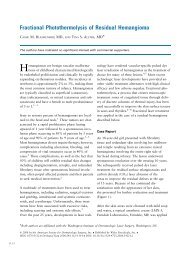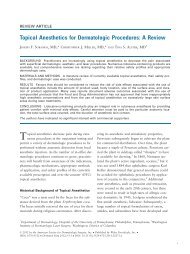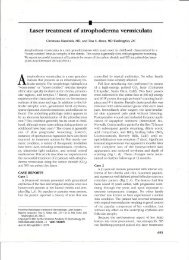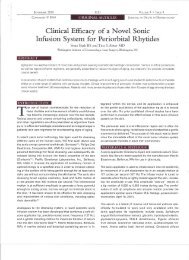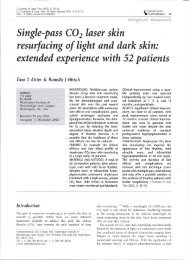Optimizing Treatment Parameters For Hair Removal Using A
Optimizing Treatment Parameters For Hair Removal Using A
Optimizing Treatment Parameters For Hair Removal Using A
Create successful ePaper yourself
Turn your PDF publications into a flip-book with our unique Google optimized e-Paper software.
SUBJECTS<br />
AND METHODS<br />
100<br />
11IIWax + Carbon + Laser<br />
11IIWax + Laser<br />
Twelve subjects (3 men and 9 women; mean age, 32<br />
years) were enrolled in the study. A total of 18 anatomic<br />
locations were evaluated, including 6 backs,<br />
3 upper lips, 1 chin, and 8 legs. Potential subjects with<br />
evidence of endocrine dysfunction, immune suppression,<br />
recent oral retinoid use, drug-induced<br />
hypertrichosis, sensitivity to infrared light, photosensitivity,<br />
collagen vascular disease, or androgenproducing<br />
tumor were excluded. Skin type, sex, hairremoval<br />
history, and patient age were recorded. All<br />
skin types were considered for inclusion, although<br />
only skin types I through IV were represented. Only<br />
subjects with black or brown terminal hair were<br />
included.<br />
A Q-switched Nd:YAG laser (Thermolase Corp)<br />
was used at a fluence of 2.6 j/crrr', a wavelength of<br />
1064 nm, a pulse duration of 50 nanoseconds, a 7-mm<br />
spot size, and a pulse repetition rate of 10 Hz. Study<br />
areas on the back and legs were divided into 3-cm 2<br />
quadrants using a standard template. Facial areas were<br />
divided into I-crrr' quadrants using a smaller template.<br />
<strong>Treatment</strong> sites were placed in a linear fashion,<br />
with orientation and location randomized for each<br />
anatomic area. Pretreatment protocol in 1 quadrant<br />
consisted of wax epilation and carbon-based solution<br />
application (Thermolase Corp) with subsequent<br />
"laser irradiation using the above set parameters.<br />
A second quadrant was wax epilated (without<br />
carbon solution) and exposed to laser radiation. A<br />
third area was exposed to laser radiation without any<br />
pretreatment waxing or carbon solution application.<br />
The last quadrant was simply wax epilated and<br />
served as a control. Those sites pretreated with carbon<br />
solution retained a thin film of surface carbon<br />
after gentle wiping of excess solution with dry gauze.<br />
The pretreated skin was subsequently irradiated<br />
within 15 minutes after the application of carbon<br />
solution.<br />
Evaluations at 1, 3, and 6 months after treatment<br />
consisted of consecutive photographic documentation<br />
using identical lighting, camera, and patient<br />
positioning (Mirror Image System, Virtual<br />
Eyes Inc, Kirkland, Wash); manual hair counts; and<br />
subjective patient hair-density estimates. <strong>Hair</strong>-density<br />
estimates were based on each patient's subjective<br />
evaluation using a scale of no hair growth,<br />
minimal or moderate growth, and thick hair growth<br />
as options.<br />
The number of terminal hairs present after treatment<br />
were compared with baseline hair counts. The<br />
percentage of hair regrowth was defined as the percentage<br />
of hairs that were present after treatment compared<br />
with baseline hair counts. Anatomic locations<br />
were grouped and analyzed separately. The percentage<br />
of hair regrowth was calculated for each study<br />
quadrant. Paired-difference t tests were used to compare<br />
treatments. Wilcoxon signed-rank tests of the<br />
paired differences were also performed for confirmation.<br />
Hochberg improved Bonferroni procedure<br />
was used to maintain a joint significance level of .05<br />
for the 4 tests within a single time point.<br />
80<br />
.x:<br />
! 60<br />
~a:<br />
~ 40<br />
20<br />
Figure 1. Mean percentage of patient hair regrowth.<br />
Waxing<br />
+<br />
Solution<br />
+<br />
Laser<br />
Waxing<br />
+<br />
Laser<br />
Waxing<br />
Alone<br />
Laser<br />
Alone<br />
Figure 2. A 45-year-old man with pigmented terminal hairs on the back<br />
before treatment.<br />
bon solution application followed by Q-switched Nd:<br />
YAG laser irradiation is more effective than wax epilation<br />
alone. It is also unclear whether the timeconsuming<br />
and messy procedure of waxing and carbon<br />
solution application is more efficacious than laser irradiation<br />
alone when used on hair-bearing skin. Therefore,<br />
the present study served to evaluate hair growth<br />
within 3 laser-treated sites with differing pretreatment<br />
protocols using a fourth wax-epilated site as a control.<br />
RESULTS<br />
<strong>Hair</strong> regrowth was evaluated by hair counts and subjective<br />
patient evaluations of hair density at each of the 3<br />
follow-up visits (at 1, 3, and 6 months). The mean percentage<br />
of regrowth (Figure 1) at 1 month was 39.9%<br />
(P




